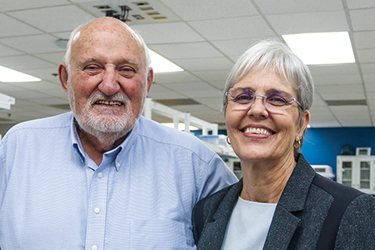Pets, Perseverance, And Manufacturing Facility Bring Biotech Success

By Ed Miseta, Chief Editor, Clinical Leader

Patricia Lawman, cofounder and CEO of the biotech firm Morphogenesis, has always been amazed at how our bodies can defeat illnesses and usually do it better than drugs. “In my younger days, it seemed the only things we had available for most diseases were drugs that addressed the symptoms of a disease, not the disease itself,” says Lawman. “I often wondered why we couldn’t figure out a way to help our bodies do what they do best — maintain health and fight disease.”
To pursue that idea, Lawman and her husband Michael founded Morphogenesis, an emerging biotech that is developing personalized immunotherapies for the treatment of cancer. Both were basic scientists with no background in the pharma industry. Michael has a Ph.D. in cell biology and immunology and spent some time with a veterinary research company. Patricia’s background is in molecular biology, immunology, and medical microbiology.
“Everything we know about the industry we have learned the hard way,” says Lawman. “We talk to a lot of people with industry experience like CROs and consultants. Our company has only 16 employees, so we try to surround ourselves with people who have experience producing products and conducting clinical trials. Thus far we have raised over $30 million in funding and have moved into clinical trials on human subjects.”
Unbeknownst to anyone, the path to Morphogenesis was started when the Lawmans recruited like-minded scientists to the Walt Disney Memorial Cancer Institute in Orlando, where Patricia served as director of cancer molecular biology and Michael was a division director. The group brainstormed ways for treating cancer and came up with some rather interesting ideas.
“We were just a group of blue-sky, starry-eyed folks who felt genes, cells, and organs were the key to treating chronic diseases,” she says. “We looked at various ways to identify stem cells, separate them from complex tissues, induce them to proliferate without differentiating them into mature lineage cells, and then to alter them genetically to perform specific functions.”
The group formed Morphogenesis and relocated to an incubator at the University of Florida. It then operated as a virtual company for a few years before relocating to a facility near the University of South Florida in Tampa. The company is currently focused on its cancer immunomodulator technology, which helps the immune system kill the cancer cells and protect the body.
LET IMMUNE SYSTEMS DO THE WORK
Immune system cells protect the body against anything foreign that seeks to harm it, even cancer. When the immune system is suppressed or fails to recognize a tumor as foreign, it needs help to defeat the cancer. The therapy being developed by Morphogenesis helps the immune system recognize the tumor as foreign so it can be destroyed. A single bacterial gene is introduced into the tumor, causing an immunogenic protein to be expressed on the surface of the tumor cells. That protein acts like a beacon to draw the immune system to it. It also creates an agenda for the immune system. Special antigen presenting cells eat the tumor cells, beacon and all, and present the small peptide pieces of the patient’s tumor antigens to other immune cells that do the killing. Any other cells in the body bearing the same tumor peptides as the injected tumor will also be targeted and destroyed.
“We put a bacterial protein on the surface of the tumor, which creates a cascade of events that educates the body,” states Lawman. “We train the patient’s immune system to kill his/her own tumor cells. This is an off-the-shelf treatment that creates a personalized response in each patient. We do not have to sequence a patient’s DNA or synthesize peptides. Once we introduce the gene, the body does the rest of the work. There is a self-replicating cycle of education and tumor cell destruction known as interantigenic epitope spreading.”
A DIFFERENT TYPE OF ANIMAL TESTING
Like most new therapies, the Morphogenesis treatment was tested on mice in preclinical studies for safety and efficacy. However, the Morphogenesis product must be injected into a patient’s tumor, so there was no way to simply inject it into a healthy mouse and see the impact via normal toxicology tests. That means the usual pharmacodynamics or pharma toxicology safety yardsticks did not necessarily apply. Safety testing required tumor-bearing mice and complex biodistribution studies.
The same thing could be said for efficacy measurements. Lab mice used in studies like these are often inbred animals and must be injected with cancer cells to form tumors. Although tests with Morphogenesis’ products yielded positive results, the company wanted to see the impact of the treatment on naturally occurring cancers, which they felt would be representative of what could be expected in humans. To do so, the company turned to the veterinary field.
“We ended up working with animal hospitals across the country to see if the treatment worked on pets/companion animals as well as it did with lab mice,” says Lawman. “That process was near and dear to our hearts. These pets were not laboratory models; they were not mice that had been bred in a lab and given cancer. They were family members. We felt that naturally occurring cancers in these animals were more akin to what we would see in humans and wanted to make sure the safety profile we had seen in mice was mirrored in large animals. Fortunately, we saw positive results at reducing or even eradicating tumors in dogs, cats, and even horses, with very minimal safety concerns.”
THE MOVE TO HUMANS
Approximately 3,000 doses were administered to pets. Morphogenesis learned a lot from the animal trials, but most important was the fact that the mechanism of action seemed to be the same in companion animals as it was in lab animals. Although the treatment is an off-the-shelf product, it is cancer agnostic and can be injected into virtually any type of tumor. Some of the work performed with veterinarians was done as clinical testing with the oversight of the USDA. This also allowed Morphogenesis to learn about regulatory processes and working with a regulatory agency. That experience stood them in good stead because now the company is ramping up multiple clinical trials in humans.
The first human trial for the treatment was a safety study conducted on patients with melanoma. Lawman notes skin cancer tumors are easily accessible, and checkpoint inhibitors have been approved for virtually all types of skin cancer. The first trial was a single-site trial at the Moffitt Cancer Center in Tampa, which is just a few hundred yards from the Morphogenesis facility. The treatment was used on six patients, and only minor side effects were noted. Most involved redness or minor pain at the injection site and were resolved quickly. These were the same side effects noted in pets that were tested.
A multi-site trial is now underway that will focus on patients with Merkel cell and cutaneous squamous cell skin cancers. One patient at Moffitt and another at the University of Southern California have already completed the protocol. That trial is expected to eventually have five open sites. Morphogenesis also hopes to start a Phase 2 trial this fall for melanoma. That trial will likely be in combination with a checkpoint inhibitor to negate immune suppression.
Patricia Lawman, cofounder and CEO, Morphogenesis
BUILD A FACILITY OR HIRE A CMO?
When it came time to produce material for its upcoming Phase 2 trials, Lawman and Morphogenesis had a decision to make: “Do we produce the material ourselves or outsource the manufacturing to a CMO?”
To make that decision Lawman did a lot of research and talked to a lot of CMOs. In fact, Morphogenesis contracted with a CMO to produce the material needed for its Phase 1 studies. The main challenge with outsourcing the manufacturing had to do with the amount of material needed for the trials.
“Patients in our trials receive a small amount of product,” states Lawman. “Each patient receives only about 100 micrograms of plasmid DNA. That’s almost nothing. If you look at DNA vaccines for infectious diseases, those treatments can use milligrams. But needing small quantities ended up being a problem for us. We found most CMOs did not want to manufacture such small batches or perform fill/finish [the final step in the production process, considered one of the most crucial stages of biologics manufacturing]. They say they do, but they don’t make it easy for small companies. Our product is a ‘sterile injectable,’ two words which carry a great deal of liability. CMOs charge dearly for that liability risk. And, if a CMO does produce a small batch, it ends up being very expensive for the sponsor company because someone still has to perform all of the same quality control testing they would for a much larger batch and assume liability for the products’ safety and integrity.”
Lawman describes the pricey quotes she received from CMOs as “mind boggling,” but timing also was an issue. With some CMOs the lead time would be at least a year, and many would not add her product to the queue without signing a contract and submitting a hefty down payment. She notes it is difficult to be a nimble and flexible company if your main bottleneck is a lead time that you have no control over.
She decided it was better to invest that money in her own company rather than hand millions of dollars over to a CMO in a one-and-done transaction. Ultimately, the company was able to build out a 12,000-square-foot manufacturing facility, plus purchase all the equipment in it, for what it would have cost for one CMO to produce enough Phase 2 product for 160 patients.
“We have a full cleanroom where we do our final sterile filtration and fill/finish,” states Lawman. “We also have a quality control testing laboratory, a lab specifically for growth and lysis of the E. coli, and a column chromatography room for isolation of the DNA. We are now set up to do all our production for the clinical trials we need to conduct as well as new products as they are developed. We are not set up for commercial production, though; that is not something we want to do. It took a lot of consulting experts, training, documentation, and repetition, but we now know more about our product than anyone else.”
The enormity and risk associated with a decision like this one is not lost on Lawman. It’s a long-term capital investment, for sure, but it’s one that she and the team at Morphogenesis have never second-guessed. “If you outsource everything, I think you can lose perspective,” she says. “Tech transfer might become easier over time, but one of my jobs here is building shareholder value. Investing all of that money into our company and our processes might not be the best decision for every company, but for us it was the right thing to do.”

